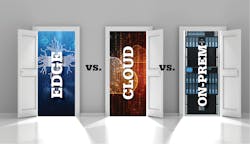This article originally appeared in the June 2023 issue of Security Business magazine. When sharing, don’t forget to mention Security Business magazine on LinkedIn and @SecBusinessMag on Twitter.
Artificial intelligence is now available on the edge, upending traditional models with sophisticated analytics that can occur as part of a VMS system design. Recent technological advancements have left many integrators unsure about how to leverage the edge, the cloud, and on-prem solutions to best deliver their customers’ needs.
Before exploring considerations and options, let’s establish some definitions:
Edge: For this discussion, the edge refers to the processing capabilities built into cameras and their ability to execute complex analytics. IT professionals often define “the edge” differently, referring to onsite servers. Because security purchase decision makers often include IT stakeholders, integrators must make this distinction clear when describing and designing systems for their clients. When talking video surveillance and video data analytics, the edge is the end device on a network.
Cloud: The cloud is made up of server farms housed in massive data centers around the world. The cloud offers unlimited storage and processing power, and companies developing products for a cloud environment pay companies like Amazon AWS, Google Cloud Platform GCP, and Microsoft Azure for their needs. Today, the cloud has the capability to host VMS platforms and run powerful video analytics.
On-premise: These systems are hosted on Microsoft OS or Linux OS servers maintained by the end-user. On-prem servers can host VMS platforms and run analytics software. They may also be used in a hybrid design, where the cloud performs big data analytics and/or video archiving.
Analytics at the Edge
The first edge analytics, performing pixel-based motion detection, came to market a little over 20 years ago. Video management systems became far more efficient when cameras could determine which video contained information worthy of transmission to the server (i.e., something was happening).
Bandwidth consumption, server-based video processing, and storage requirements were all reduced. Those benefits remain relevant today; however, edge analytic capabilities have evolved dramatically with machine learning and deep learning development.
Camera manufacturers now offer edge-based artificial intelligence to identify objects like people and vehicles, recognize behavior patterns, and more. In addition, edge integrations with third-party analytics software are readily available. These solutions can be trained to identify specific objects or conditions, supporting highly customized applications.
Edge intelligence has expanded the use of cameras beyond security. Cameras can now transmit metadata instead of (or in addition to) full-frame video, feeding valuable data to operations and marketing teams.
A camera might report the number of people that spent more than 5 seconds in front of a retail display, the frequency with which cars occupied a handicapped parking spot, or the times of day when cashier lines exceeded three people. For many businesses, metadata is a treasure trove of actionable business insights that can help them run more efficiently. Security integrators who understand how to sell the value of such solutions offer stakeholders a means to justify spreading the expense of security cameras across multiple cost centers.
As exciting as the modern edge may be, there remain limits to what it can do. For now, edge analytics have difficulty identifying and tracking multiple objects going in different directions simultaneously. For example, roadway intersections, airport baggage claims, and train platforms are locations where edge analytics may be outmatched by the level and type of activity present.
Also, facial recognition (FR) cannot be performed entirely at the edge because it requires matching faces against a database that resides on a server or in the cloud; however, the edge can make FR run more quickly and efficiently as part of a hybrid solution. Cameras can distinguish and isolate faces from the rest of a video frame. Then, they can transmit just the faces to the FR analytics platform for matching against a database.
FR requires a lot of computational power – especially when matching against massive databases like the DMV. When cameras perform the initial work of separating the faces from the video, FR has a much easier job to do and requires far less processing power.
The same is true for license plate recognition (LPR) applications. Edge devices can “read” license plates and convert them into metadata for matching against lists of authorized and prohibited vehicles that reside on-prem or in the cloud.
Analytics in the Cloud
The cloud’s infinitely scalable computing power makes it an obvious choice for analytics applied to vast databases or data sources. The previous example of matching faces against state or national DMV databases is one such application. Another would be forensic analysis of video from extensive camera networks. Today, cloud analytics can search recorded video from thousands of citywide cameras for a particular car make and model, or a person wearing a blue backpack and red baseball cap. While results are not immediate, they are fast enough to provide quality leads for investigation.
The rise of AI-driven computer vision that can “understand” what cameras observe and recommend or initiate appropriate responses is driving a new generation of cloud analytics. Such solutions primarily support business operations and outcomes rather than physical security challenges. For example, retailers will soon leverage computer vision to know what’s on their shelves in real-time, while manufacturers and distributors will automate visual quality inspections.
These types of cloud analytics will likely work in combination with edge analytics. The edge will perform item or situation “detection,” transmitting either still or video images to the cloud for processing by an analytics engine that’s linked to a gigantic database of imagery.
On-Prem Analytics
Given the edge's convenience and the cloud's power, when do on-prem analytics deliver the best solution? When both speed and power are needed.
High-end graphic processing units (GPUs) within on-prem servers can perform far more advanced analytics than edge solutions. Plus, when video does not transmit to the cloud and back through crowded internet pipelines, results are delivered much more quickly – in close to real-time.
For complicated live video analysis – like monitoring crowded public places for suspicious behavior – on-premise servers can provide actionable intelligence before security threats escalate.
The downside of these solutions is that they can be very costly. They are also not scalable like the cloud, as each GPU can only process so many concurrent video streams at once.
As with cloud analytics, on-prem analytics can function more efficiently when combined with edge analytics. A hybrid architecture that deploys processing at the edge reduces the burden placed on the server, allowing it to deliver faster and potentially more accurate results.
Choosing the Right VMS
Today, on-prem VMS solutions hold about 60% of the U.S. market, but cloud deployments are quickly gaining ground. By 2030, market research firms predict that cloud installations will be the dominant model.
End-users are attracted to cloud systems’ operating expense (OPEX) tax status and generally lower total-cost-of-ownership. Integrators are drawn to their ease of installation, automated software updates, and RMR.
Cloud surveillance architecture is also good for the environment. By using less power, the cloud reduces carbon emissions by 88 percent. That said, integrators should understand that there are two categorically different types of cloud VMS solutions, the strengths of each, and many environments in which on-prem solutions remain the better choice.
Hybrid cloud: Most cloud VMS solutions still require an onsite server or appliance that consolidates the video before pushing it to the cloud – thus the “hybrid” label. In addition to the benefits of cloud architecture, many SMBs go this route because it offers a fast and easy way to get a basic camera system up and running with low up-front cost and little need for in-house IT support. These systems also offer unlimited scalability, as new cameras can be brought online at any time without expanding network infrastructure.
The initial benefits are very appealing, but buyers should also be made aware of these systems’ shortcomings. First, because they rely on a centralized onsite appliance to connect with the cloud, there is a looming possibility that a single point of failure could take down the entire system. In some environments, that is an unacceptable security risk.
Second, some of these cloud solutions work only with proprietary cameras that are sold as part of the package. The cameras will not work with any other VMS platform, locking customers in. If they decide to stop paying monthly licensing fees, or if the solution manufacturer goes out of business, their cameras become bricks.
Third, analytics are also limited to what is available as part of the system and options to integrate with more sophisticated third-party solutions are mostly non-existent. Fourth, integrations with other third-party security solutions, like access control and visitor management, are limited.
SMBs hoping to expand their system’s capabilities over time, moving video management out of a silo and into part of a comprehensive security technology ecosystem, may decide that the confines the hybrid-cloud outweigh the immediate benefits.
Edge-to-cloud: For systems with fewer than 15 cameras, there is another cloud option without the same limitations. These require no in-house server. Cameras stream directly to the cloud, where the video is stored and accessible to system administrators to view and manage. The primary consideration is whether the site has adequate bandwidth to stream the video to the cloud. Several camera manufacturers support this capability. If the connected cameras feature edge analytics, they too can be shared with the cloud VMS platform.
While edge-to-cloud systems are best for small installations, they are also practical for enterprise organizations with many small locations, like bank branches or franchise outlets. The edge-to-cloud option provides many of the same benefits as an on-prem system but without the need for extensive local IT staff to support it.
On-prem: While most cloud solutions include robust, built-in cybersecurity features, many companies still prefer to keep sensitive data onsite and completely within their control. In some sectors, compliance issues may even prohibit the use of the cloud.
ONVIF-compliant on-prem systems also offer the broadest camera choices and integration options. Customers seeking highly customized solutions can work with consultants or integrators to address almost any security challenge by combining disparate technologies that communicate through open APIs. With freedom of camera choice comes access to the very best edge analytics powered by artificial intelligence and machine learning.
Leveraging the Edge
New chip designs have transformed today’s IP cameras and other security devices into powerful, self-learning analytic engines. For many applications, sophisticated detection of situations or objects no longer requires integrating expensive third-party software with a VMS platform. The edge can do it!
When evaluating camera capabilities, look for models that reference “machine learning” or “deep learning” within their specifications. They are the ones that will deliver a future proof solution – capable of evolving to solve problems customers may have not yet identified.
The edge adds value when combined with either cloud or on-prem VMS solutions. For integrators, understanding what their customers are trying to achieve, as well as the strengths and capabilities of each platform, are critical to delivering solutions based on best practices. For integrators, leveraging the modern edge within project designs may be key to gaining their own edge and closing more opportunities.
Robert Muehlbauer is Senior Manager of Business Development for Axis Communications. Visit www.securityinfowatch.com/10212966 to learn more about the company and request information.



